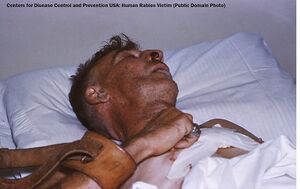Rabies: Difference between revisions
No edit summary |
Kim Jackson (talk | contribs) m (Text replacement - "[[Cognitive Deficits" to "[[Cognitive Impairments") |
||
| (47 intermediate revisions by 8 users not shown) | |||
| Line 1: | Line 1: | ||
<div class="editorbox"> | |||
'''Original Editors '''- Deric Parrish [[Pathophysiology of Complex Patient Problems|from Bellarmine University's Pathophysiology of Complex Patient Problems project.]] | '''Original Editors '''- Deric Parrish [[Pathophysiology of Complex Patient Problems|from Bellarmine University's Pathophysiology of Complex Patient Problems project.]] | ||
''' | '''Top Contributors''' - {{Special:Contributors/{{FULLPAGENAME}}}} | ||
</div> | </div> | ||
== Introduction == | |||
[[File:Human rabies victim.jpeg|thumb|Human with rabies.]] | |||
Rabies is a [[Vaccines|vaccine]]-preventable, [[Zoonotic Diseases|zoonotic]], [[Viral Infections|viral]] disease, that causes viral [[encephalitis]], killing up to 70,000 people/year worldwide.<ref name=":1" /> | |||
* Dogs are the source of the most rabies virus transmissions, through bites or scratches, usually via saliva. When clinical symptoms appear, rabies is virtually 100% fatal.<ref name=":0">World Health Organisation [https://www.who.int/westernpacific/health-topics/rabies#tab=tab_1 Rabies] Available:https://www.who.int/westernpacific/health-topics/rabies#tab=tab_1 (accessed 18.12.2022)</ref> | |||
* Rabies elimination is feasible through vaccination of dogs, prevention of dog bites and ensuring universal access to post-exposure immunization.<ref name=":0" /> | |||
== Epidemiology == | |||
[[File:Nick-bolton-bbiDkAEmC9s-unsplash.jpeg|thumb|Dog bite, usual route of transmission]] | |||
Researchers estimate that 30,000 to 70,000 deaths are attributable to rabies each year.<ref name=":1">Koury R, Warrington SJ. [https://www.ncbi.nlm.nih.gov/books/NBK448076/ Rabies]. StatPearls [Internet]. 2022 Jan.Available:https://www.ncbi.nlm.nih.gov/books/NBK448076/ (accessed 18.12.2022)</ref> As noted by many in the past, human rabies deaths is only an estimate as it remains underreported <ref name=":2">Ghai S, Hemachudha T. [https://www.frontiersin.org/articles/10.3389/fvets.2022.847659/full Continued failure of rabies elimination–consideration of challenges in applying the One Health approach.] Frontiers in Veterinary Science. 2022 Mar 29:307.Available:https://www.frontiersin.org/articles/10.3389/fvets.2022.847659/full (accessed 18.12.2022)</ref> | |||
Rabies exists on all continents, except Antarctica, with over 95% of human deaths occurring in the Asia and Africa regions. Rabies predominantly affects poor and vulnerable populations who live in remote rural locations, with around 80% of human cases occur in rural areas. Globally, rabies deaths are rarely reported and children between the ages of 5–14 years are frequent victims.<ref name=":0" /> | |||
== Etiology == | |||
Post exposure to the saliva of an infected animal, the symptoms of rabies's usually start to show within 2 to 3 months but a large range exists, from 5 days to a year post exposure. Upon entering the body the virus travels along the nerves to the central nervous system producing inflammation. | |||
Variables affecting time from exposure to being symptomatic include: the amount of virus entering the body; the size of the wound; how close the wound is to the brain.<ref name=":3">Queensland Government [http://conditions.health.qld.gov.au/HealthCondition/condition/14/217/118/Rabies Rabies] Available:http://conditions.health.qld.gov.au/HealthCondition/condition/14/217/118/Rabies (accessed 18.12.20220</ref><ref name="funk">Funk & Wagnalls New World Encyclopedia. RABIES. (n.d.),Available:https://www.ccconline.org/funk-wagnalls-new-world-encyclopedia/ [cited March 17, 2011]</ref> | |||
== Characteristics/Clinical Presentation == | |||
Clinically, it has two forms: | |||
# Furious rabies is the most common with symptoms consisting of hydrophobia, hyperactivity, hallucinations and pharyngeal spasms leading to paralysis, [[coma]] and death. | |||
# Paralytic rabies is less common and presents as paralysis leading to death. | |||
There are five stages of the disease: | |||
== | # Incubation phase which can range from 10 days to 2 years. | ||
# Prodrome stage in which flu-like symptoms may be present. | |||
# Acute neurological symptom stage where more [[Introduction to Neuroanatomy|CNS]] involvement is noted with symptoms such as [[diplopia]], [[dysarthria]], [[nystagmus]], mild to moderate paralysis, [[Cognitive Impairments|confusion]], anxiety, paranoia, insomnia, hallucinations or delerium. Excessive saliva, difficulty swallowing and fear of water and other liquids can also present in this stage of the disease. | |||
#[[Coma]] | |||
# Death.<ref name="clarification article">Driver C. [https://www.nursingtimes.net/archive/rabies-risk-prognosis-and-prevention-28-03-2014/ Rabies: risk, prognosis and prevention]. Nursing times. 2014 Apr 1;110(14):16-8.Available:https://www.nursingtimes.net/archive/rabies-risk-prognosis-and-prevention-28-03-2014/ (accessed 23.12.2022)</ref><ref name="Powell">Powell JC, Berryman P, Lukes E. [https://pubmed.ncbi.nlm.nih.gov/19968210/ Evaluating risk: rabies exposure and occupational implications.] AAOHN journal. 2009 Nov;57(11):465-73. Available:https://pubmed.ncbi.nlm.nih.gov/19968210/ (accessed 23.12.2022)</ref> | |||
== Treatment == | |||
[[File:Child receiving rabies innoculation.png|thumb|After a dog bite boy receives a rabies vaccine]] | |||
There is no effective treatment for rabies. <ref name=":1" /> | |||
* Because the disease caused by rabies is nearly always lethal, anyone potentially exposed should have the post-exposure vaccination, if required (including people who may be allergic and women who are pregnant or breastfeeding). | |||
* A course of rabies vaccine is needed after potential exposure and if needed, administration of human rabies [[Immunoglobulins (Ig)|immunoglobulin]]. The vaccine stimulates the [[Immune System|immune system]] to produce antibodies that destroy the virus before it has time to cause an illness. | |||
* Wound care: immediately wash the wound thoroughly. If available, after washing, an antiseptic with anti-virus action such as povidone-iodine or alcohol (ethanol).<ref name=":3" /> | |||
== | == Elimination == | ||
The goal and approaches to eliminate rabies, a disease with clear transmission dynamics, although well-accepted, are not successful to date.<ref name=":2" /> Rabies elimination is achievable through vaccination of dogs, prevention of dog bites and securing universal access to post-exposure immunization. This requires a whole-of-system approach with a multisectoral interventions and community engagement.<ref name=":0" /> | |||
== References == | |||
<references /> | |||
== References | |||
<references /> | |||
[[Category:Bellarmine_Student_Project]] | [[Category:Bellarmine_Student_Project]] | ||
[[Category:Conditions]] | |||
[[Category:Communicable Diseases]] | |||
Latest revision as of 11:16, 17 February 2023
Original Editors - Deric Parrish from Bellarmine University's Pathophysiology of Complex Patient Problems project.
Top Contributors - Deric Parrish, Lucinda hampton, Admin, Kim Jackson, Elaine Lonnemann, WikiSysop, 127.0.0.1, Wendy Walker and Vidya Acharya
Introduction[edit | edit source]
Rabies is a vaccine-preventable, zoonotic, viral disease, that causes viral encephalitis, killing up to 70,000 people/year worldwide.[1]
- Dogs are the source of the most rabies virus transmissions, through bites or scratches, usually via saliva. When clinical symptoms appear, rabies is virtually 100% fatal.[2]
- Rabies elimination is feasible through vaccination of dogs, prevention of dog bites and ensuring universal access to post-exposure immunization.[2]
Epidemiology[edit | edit source]
Researchers estimate that 30,000 to 70,000 deaths are attributable to rabies each year.[1] As noted by many in the past, human rabies deaths is only an estimate as it remains underreported [3]
Rabies exists on all continents, except Antarctica, with over 95% of human deaths occurring in the Asia and Africa regions. Rabies predominantly affects poor and vulnerable populations who live in remote rural locations, with around 80% of human cases occur in rural areas. Globally, rabies deaths are rarely reported and children between the ages of 5–14 years are frequent victims.[2]
Etiology[edit | edit source]
Post exposure to the saliva of an infected animal, the symptoms of rabies's usually start to show within 2 to 3 months but a large range exists, from 5 days to a year post exposure. Upon entering the body the virus travels along the nerves to the central nervous system producing inflammation.
Variables affecting time from exposure to being symptomatic include: the amount of virus entering the body; the size of the wound; how close the wound is to the brain.[4][5]
Characteristics/Clinical Presentation[edit | edit source]
Clinically, it has two forms:
- Furious rabies is the most common with symptoms consisting of hydrophobia, hyperactivity, hallucinations and pharyngeal spasms leading to paralysis, coma and death.
- Paralytic rabies is less common and presents as paralysis leading to death.
There are five stages of the disease:
- Incubation phase which can range from 10 days to 2 years.
- Prodrome stage in which flu-like symptoms may be present.
- Acute neurological symptom stage where more CNS involvement is noted with symptoms such as diplopia, dysarthria, nystagmus, mild to moderate paralysis, confusion, anxiety, paranoia, insomnia, hallucinations or delerium. Excessive saliva, difficulty swallowing and fear of water and other liquids can also present in this stage of the disease.
- Coma
- Death.[6][7]
Treatment[edit | edit source]
There is no effective treatment for rabies. [1]
- Because the disease caused by rabies is nearly always lethal, anyone potentially exposed should have the post-exposure vaccination, if required (including people who may be allergic and women who are pregnant or breastfeeding).
- A course of rabies vaccine is needed after potential exposure and if needed, administration of human rabies immunoglobulin. The vaccine stimulates the immune system to produce antibodies that destroy the virus before it has time to cause an illness.
- Wound care: immediately wash the wound thoroughly. If available, after washing, an antiseptic with anti-virus action such as povidone-iodine or alcohol (ethanol).[4]
Elimination[edit | edit source]
The goal and approaches to eliminate rabies, a disease with clear transmission dynamics, although well-accepted, are not successful to date.[3] Rabies elimination is achievable through vaccination of dogs, prevention of dog bites and securing universal access to post-exposure immunization. This requires a whole-of-system approach with a multisectoral interventions and community engagement.[2]
References[edit | edit source]
- ↑ 1.0 1.1 1.2 Koury R, Warrington SJ. Rabies. StatPearls [Internet]. 2022 Jan.Available:https://www.ncbi.nlm.nih.gov/books/NBK448076/ (accessed 18.12.2022)
- ↑ 2.0 2.1 2.2 2.3 World Health Organisation Rabies Available:https://www.who.int/westernpacific/health-topics/rabies#tab=tab_1 (accessed 18.12.2022)
- ↑ 3.0 3.1 Ghai S, Hemachudha T. Continued failure of rabies elimination–consideration of challenges in applying the One Health approach. Frontiers in Veterinary Science. 2022 Mar 29:307.Available:https://www.frontiersin.org/articles/10.3389/fvets.2022.847659/full (accessed 18.12.2022)
- ↑ 4.0 4.1 Queensland Government Rabies Available:http://conditions.health.qld.gov.au/HealthCondition/condition/14/217/118/Rabies (accessed 18.12.20220
- ↑ Funk & Wagnalls New World Encyclopedia. RABIES. (n.d.),Available:https://www.ccconline.org/funk-wagnalls-new-world-encyclopedia/ [cited March 17, 2011]
- ↑ Driver C. Rabies: risk, prognosis and prevention. Nursing times. 2014 Apr 1;110(14):16-8.Available:https://www.nursingtimes.net/archive/rabies-risk-prognosis-and-prevention-28-03-2014/ (accessed 23.12.2022)
- ↑ Powell JC, Berryman P, Lukes E. Evaluating risk: rabies exposure and occupational implications. AAOHN journal. 2009 Nov;57(11):465-73. Available:https://pubmed.ncbi.nlm.nih.gov/19968210/ (accessed 23.12.2022)









